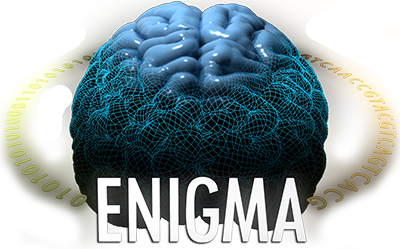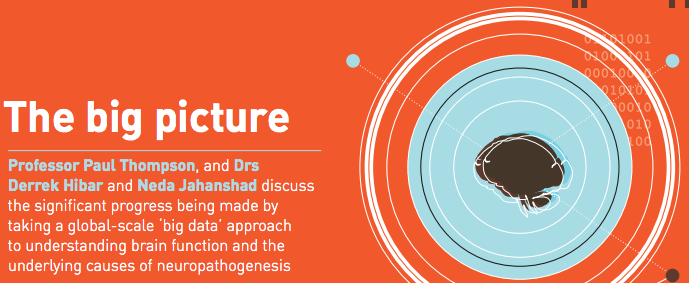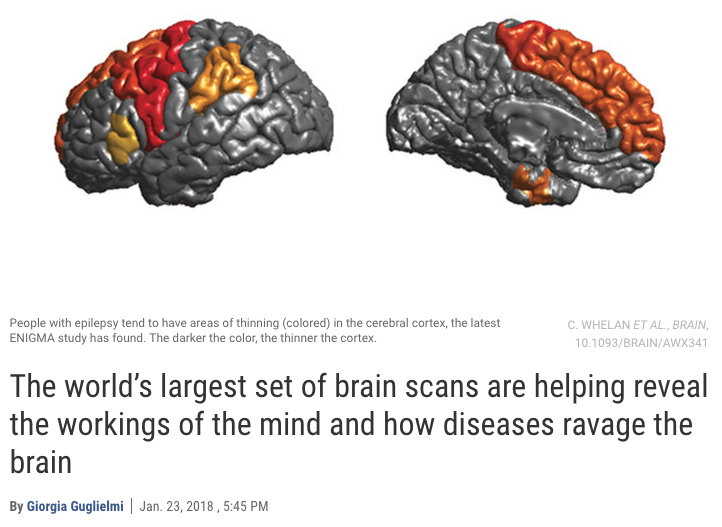
The Lancet, 2015 | ENIGMA: crowdsourcing meets neuroscience The Guardian, 2015 | Chronic depression shrinks brain's memories and emotions
The Conversation, 2015 | Depression damages parts of the brain, research concludes International Innovation, 2015 | Cracking the Brain's Genetic Code (high res) (low res)
Recent ENIGMA Press Articles

Featured Articles
ADHD Institute October 26, 2015 Future directions in the neurobiological understanding of ADHD: the ENIGMA Consortium
Understanding of the neurobiological correlates of ADHD may be further enhanced through the work of the Enhancing NeuroImaging Genetics through Meta-Analysis (ENIGMA) Consortium, a collaborative network of researchers working together to analyse neuroimaging data from 70 institutions around the world.A recent report has published the latest findings and future directions of ENIGMA studies, of which some are specifically related to ADHD. ENIGMA studies have analysed data from over 12,826 subjects, with a unified goal to bring together researchers with genome-wide images and data to build a comprehensive understanding of the brain that no individual site could investigate alone.There are several ENIGMA disease working groups, who assess the impact of genetic variants on the brain and behaviour in specific diseases; one such group is currently being formed for ADHD, which will analyse data from >1500 children and adults with the disorder and >2000 controls. Although ENIGMA researchers acknowledge that these data are likely to be heterogeneous in terms of duration of illness, disease aetiology, medication history, demographics, exposure to neuroprotective substances and many other factors, they also suggest that this will provide the opportunity to assess which of these factors are likely to affect disease expression in the brain with a sample size of sufficient power.Eventually, ENIGMA researchers hope to conduct cross-disorder meta-analyses on representative datasets from a range of psychiatric disorders, including ADHD, schizophrenia, bipolar disorder, depression, autism, obsessive-compulsive disorder and addiction, to identify common and distinctive patterns of brain morphometry with potential implications for diagnostic criteria.Medical News Today July 2, 2015 Major Depression tied to smaller hippocampus The largest international study to compare brain volumes of people with major depression to those of healthy people finds the former tend to have a significantly smaller hippocampus.Major depression is a serious mood disorder that affects around 1 in 6 people during their lifetime.When it occurs, persistent feelings of sadness, frustration, loss or anger disrupt everyday life and can endure for weeks, months or even years.The hippocampus - whose name comes from the Ancient Greek word for "seahorse" because of its shape - is an area of the brain that, among other things, is associated with forming new memories.The ENIGMA study researchers, including a group from the Brain and Mind Research Institute (BMRI) at the University of Sidney in Australia, suggest their findings highlight a need to treat depression when it first occurs - especially in adolescents and young adults.For the global study - which brings together 15 data sets from Europe, the USA and Australia - the team analyzed magnetic resonance imaging (MRI) brain scans of nearly 9,000 participants: 1,728 with major depression and 7,199 healthy individuals.They also had access to clinical records of the participants with depression.The researchers report their findings in the journal Molecular Psychiatry.The study has two main findings. The first - which confirms earlier clinical work at the BMRI - is that people with major depression have a smaller hippocampus.The second finding is that the first finding is largely accounted for by people with recurrent depression - they represented 65% of the major depression participants.Recurrent depression is a form of major depression where the depressive episodes come back regularly, interspersed with periods of no depression.Another interesting finding is that people whose major depression started before they reached the age of 21 also had a smaller hippocampus. The researchers suggest this is consistent with the idea that many of these youngsters go on to have recurrent depression.However, participants who had not experienced more than one episode of major depression - 34% of those with major depression - did not have a smaller hippocampus than the healthy subjects.Jim Lagopoulos, an associate professor at BMRI, says these findings reveal new information about our brain structures and the mechanisms that might underlie depression. He adds:"Despite intensive research aimed at identifying brain structures linked to depression in recent decades, our understanding of what causes depression is still rudimentary."He says one reason we know so little about this is the lack of studies with sufficiently large numbers of participants. Another reason is the disease varies widely, as do the treatments, and there are also complex interactions between some of the clinical characteristics and brain structure.Co-author Ian Hickie, professor and co-director of BMRI, says the clinical implications of the findings are that we probably need to treat first episodes of depression effectively, "particularly in teenagers and young adults, to prevent the brain changes that accompany recurrent depression."He says there is also a clear need for studies that can track changes in hippocampus size over time in people with depression. Results from such studies would help to clarify the question of cause and effect, "whether hippocampal abnormalities result from prolonged duration of chronic stress, or represent a vulnerability factor for depression, or both."Prof. Lagopoulos also suggests the study lends support to the "neurotrophic hypothesis of depression," the idea that people with chronic depression have certain differences in brain biology - such as sustained higher levels of glucocorticoid - that shrink the brain.Meanwhile, Medical News Today recently learned about new research that suggests brain inflammation links chronic pain with depression. The study is the first to discover brain inflammation caused by chronic nerve pain can affect signaling in regions associated with mood and motivation.The Conversation June 30, 2015 Depression damages parts of the brain, research concludes Brain damage is caused by persistent depression rather than being a predisposing factor for it, researchers have finally concluded after decades of unconfirmed hypothesising.A study published in Molecular Psychiatry today has proved once and for all that recurrent depression shrinks the hippocampus - an area of the brain responsible for forming new memories - leading to a loss of emotional and behavioural function.Hippocampal shrinkage has long been linked to depression but previous studies haven’t been conclusive. Small sample sizes, varying types of depression and treatment levels, as well as variance in methods for collecting and interpreting results, have together led to inconsistent and often conflicting findings.Now, with the help of what co-author Ian Hickie from the Brain and Mind Research Institute has called “a new spirit of collaboration” a global, cross-sectional analysis of brain scans of 9,000 people has conclusively linked brain damage to depression.“I think this resolves for good the issue that persistent experiences of depression hurts the brain,” said Professor Hickie.Hippocampal shrinkage was pronounced among those for whom depression started early (before the age of 21), as well as people who had recurrent episodes. Professor Hickie noted that it was this persistence that “does the damage”.“Those who have only ever had one episode do not have a smaller hippocampus, so it’s not a predisposing factor but a consequence of the illness state.”“It puts the emphasis then on early identification of the more severe persistent or recurrent cases. Importantly, in early identification systems you have to stick with those in who it persists or is recurrent, because they’re the ones who will be most harmed from a brain point of view.”Researchers used magnetic resonance imaged (MRI) brain scans and clinical data from 1,728 people with major depression and 7,199 healthy individuals, combining 15 datasets from Europe, the USA and Australia.The samples were obtained from the ENIGMA group database - an international consortium investigating psychiatric disorders.Scientia Professor & Head of the School of Psychiatry at UNSW Philip Mitchell said the use of the consortium’s ongoing sample collection was “becoming a very powerful way of looking at what’s happening in brain function”.“This study confirms - in a very large sample - a finding that’s been reported on quite a few occasions. It’s interesting that none of the other subcortical areas of the brain have come up as consistently, so it also confirms that the hippocampus is particularly vulnerable to depression.”The hippocampus is part of the brain’s limbic system, or what’s otherwise known as its emotional centre. The system also contains the amygdala, another part of the brain shown to be affected by depression.While the hippocampus plays an important role in consolidating and forming new memories, Professor Hickie explained that “memories” weren’t just about remembering passwords.“Your whole sense of self depends on continuously understanding who you are in the world – your state of memory is not about just knowing how to do Sudoku or remembering your password – it’s the whole concept we hold of ourselves,” he said.“We’ve seen in a lot of other animal experiments that when you shrink the hippocampus, you don’t just change memory, you change all sorts of other behaviours associated with that - so shrinkage is associated with a loss of function.”Professor of psychiatry at Monash University Paul Fitzerald said while the findings of the study were important, they were unlikely to immediately affect clinical treatment.“I don’t think there’s anything that’s really, fundamentally going to change overnight – but it’s an important part of the jigsaw puzzle to put together a better understanding of what’s going on in depression and that obviously has implications for developing better treatments down the track,” he said.He added that researchers should next measure the volumes of individual regions within the hippocampus, that are each responsible for different cognitive functions.“Having a better understanding of what the regional volume differences are will provide greater capacity to draw conclusions,” he said.“Hopefully having the involvement of the hippocampus in depression confirmed in such as substantive study will stimulate attempts to better understand what this means.”It’s important to note however, that the effects of depression on the brain are reversible with the right treatment for the individual.“The hippocampus is one of the most important regenerative areas of the brain,” said Professor Hickie.Genetics analysis parameters June 24, 2010 Genetics analysis parameters of hippocampus GWAS analysis discussed through teleconference. Imaging Protocols of GWAS Analysis June 8, 2010 Imaging protocols of hippocampus GWAS analysis discussed at the Organization for Human Brain Mapping 2010 Meeting in Barcelona, Spain. Introduction to Imaging Genetics Educational Course June 6, 2010 Taught at the Organization for Human Brain Mapping 2010 Meeting in Barcelona, Spain. The 2010 International Workshop on Statistical Genetics and Methodology of Twin and Family Studies: The Introductory Course. March 1 – 5, 2010 Scripts and presentations from the 2010 International Statistical Genetics Methods Workshop. Lancet Neurology March 24, 2015 ENIGMA: crowdsourcing meets neuroscience ENIGMA in International Innovation May 4th, 2015 | Issue 179: 'The Enigma' Professor Paul Thompson, and Drs Derrek Hibar and Neda Jahanshad discuss the significant progress being made by taking a global-scale ‘big data’ approach to understanding brain function and the underlying causes of neuropathogenesis. ENIGMA in Science Magazine October 9, 2014 Hoping to tame the torrent of data churning out of biology labs, the National Institutes of Health (NIH) today announced [awards] in 2014 to help researchers develop ways to analyze and use large biological data sets. Professor Dan Stein in Cape Town South Africa talks about ENIGMA October 14, 2014 The combined data is so vast that no one scientist could ever analyse it on their own. Together, we can screen each other's data to discover genes or medications that influence a range of neuropsychiatric disorders. 2012 ENIGMA Newsletter December 20, 2012 2012 has been a productive year for ENIGMA! Read about all our successful efforts this year and working groups set up for projects in 2013. If you are interested in joining any project, individual contact information is provided. GWAS and Anatomy April 20, 2012 Alzheimer's Research Forum - Pooled Data Fingers Genes Driving Brain Size, IQ Giant imaging study identifies genes that govern brain size April 19, 2012 SFARI - The largest brain imaging study ever performed has identified candidate genes that influence brain size and general intelligence... ENIGMA-KCBS Thompson Interview April 16, 2012 Listen to an interview with principle investigator, Paul Thompson, about ENIGMA's work. Tiny gene change affects brain size, IQ: scientists April 16, 2012 Agence France Presse, Tehran Times - An international team of scientists said Sunday the largest brain study of its kind had found a gene linked to intelligence, a small piece in the puzzle as to why some people are smarter than others. also World News Australia Crowd-Sourcing Expands Power of Brain Research April 15, 2012 New York Times - In the largest collaborative study of the brain to date, scientists using imaging technology at more than 100 centers worldwide have for the first time zeroed in on genes that they agree play a role in intelligence and memory. Scientists at UCLA, worldwide collaborate to map brain size genes April 15, 2012 LA Times - Scientists have published a new map of gene variations that influence the risk for various brain diseases and conditions, including Alzheimer’s. Lancet Neurology |
The Guardian June 30th, 2015
Chronic depression shrinks brain's memories and emotions The hippocampus, an area of the brain responsible for memory and emotion, shrinks in people with recurrent and poorly treated depression, a global study has found.The findings highlighted the importance of treating depression early, particularly in teenagers and young adults, the study concluded.Fifteen research institutes around the world, including from the US, Europe and Australia, collaborated to combine the results of their existing, smaller studies comparing the hippocampuses of depressed and healthy people.This allowed them to examine the brain magnetic resonance imaging data of 8,927 people, 1,728 of whom had major depression and the rest of whom were healthy.The researchers found 65% of the depressed study participants had recurrent depression and it was these people who had a smaller hippocampus, which is near the centre of the brain and is involved with long-term memory, forming new memories, and connecting emotions to those memories.The findings of the largest international study to compare brain volumes in people with and without major depression were published in the medical journal Molecular Psychiatry.The University of Sydney’s brain and mind research institute led the Australian arm of the study. Its co-director, Professor Ian Hickie, said those people in the study experiencing their first depressive episode had a normal hippocampus size.“But the more episodes of depression a person had, the greater the reduction in hippocampus size,” he said.“So recurrent or persistent depression does more harm to the hippocampus the more you leave it untreated. This largely settles the question of what comes first: the smaller hippocampus or the depression? The damage to the brain comes from recurrent illness.”Hickie, who is also a national mental health commissioner, said it meant identifying and treating depression effectively when it first occurred was vital to prevent this damage, particularly among teenagers and young adults.But there was good evidence that with treatment, the damage was reversible, he said.“Other studies have demonstrated reversibility, and the hippocampus is one of the unique areas of the brain that rapidly generates new connections between cells, and what are lost here are connections between cells rather than the cells themselves,” Hickie said.“Treating depression effectively does not just mean medicines. If you are unemployed, for example, and then sit in a room doing nothing as a result, this can shrink the hippocampus. So social interventions are just as important, and treatments such as fish oils are also thought to be neuro-protective.”There was some evidence that the hippocampus was larger in those patients taking antidepressants, Hickie said, indicating these medications could have a protective effect.“There is a lot of nonsense said about antidepressants that constantly perpetuates the evils of them, but there is a good bit of evidence that they have a protective effect,” he said.“But that doesn’t mean they are the only treatment. There are, in fact, a broad range of treatments that should be explored, and in young people psychotherapy would often be explored as the first line of treatment, not medicines.”A co-author of the study, Associate Professor Jim Lagopoulos, said the findings provided new insight on brain structures and possible mechanisms responsible for depression.It also indicated the findings that were possible through collaboration.“Despite intensive research aimed at identifying brain structures linked to depression in recent decades, our understanding of what causes depression is still rudimentary,” he said.“One reason for this has been the lack of sufficiently large studies, variability in the disease and treatments provided, and the complex interactions between clinical characteristics and brain structure.”BBRF (formerly NARSAD) June 26, 2015 Innovative Analysis Finds Unique Brain Structure Patterns in People with Schizophrenia In the first study of its kind, researchers have found unique brain structure patterns among people with schizophrenia, providing insight into how the condition may develop and respond to treatment.Differences in brain structure have been noted in people with schizophrenia for decades. Ideally, such information should help us understand causes, progression and even treatment effects. Yet brain differences are influenced by many factors, some with opposing effects. Moreover, studies performed by different teams with different methods and standards have made it hard to distill results.Reporting June 2nd in Molecular Psychiatry, an international team called the ENIGMA Schizophrenia Working Group––19 of whose members are current and past NARSAD grantees*––presented a profile of brain abnormalities based on 15 schizophrenia cohorts worldwide. It was a first test of a way to analyze imaging data across traditional diagnostic boundaries. The aim: to generate “robust and consistent anatomical fingerprints associated with brain disorders to help formulate improved diagnostic classifications based on both brain and behavioral evaluations,” the team said.The ENIGMA group confirmed that people with schizophrenia had some smaller brain regions compared with healthy controls: the hippocampi, twin structures on either side of the brain that are associated with memory; the amygdalae, another paired structure found in both brain hemispheres that are important for emotional processing; and the thalami, twin structures associated with the relay of sensory and motor information. They also noted that intracranial volume, a general measure of brain size, was smaller than average in people with the illness.The team found two structures larger than normal in people with schizophrenia: the pallidum, involved in motivation and emotion; and the lateral ventricles, important cavities in the brain. These findings add to the evidence that schizophrenia is characterized by specific abnormalities of deep brain structures.The structural differences linked with schizophrenia in this study varied depending on factors such as age and sex, highlighting the variability of the illness. The biggest difference among people with schizophrenia was their smaller hippocampi, most pronounced among people who had never received medicine (typically, antipsychotic medicine) for their schizophrenia symptoms. This finding supports previous evidence that untreated schizophrenia may involve abnormal development of the hippocampus and that this can be reduced or reversed by treatment with antipsychotic medication.Future work will examine how these structural differences unfold across the lifespan in affected individuals who take antipsychotic medications and those who do not. The team calls for attention in future studies to environmental and lifestyle factors that can affect brain structure, including nutrition levels, water intake, exercise, drug use, social isolation, and stress. Future research by ENIGMA will include the study of brain characteristics among family members of people with schizophrenia, as well as different measures of brain structure, and possible relationships between the structural differences found in this study and individual patients’ experience of schizophrenia symptoms.Biomedical Computation June 1, 2015 Schizophrenia and the Thinking Brain: A Matter of Gray Matter Schizophrenia patients often experience disorganized thinking, hallucinations, and problems with attention, memory and language. And that in turn suggests a problem with the brain’s gray matter. “The gray matter is where the good stuff happens,” says Jessica Turner, PhD, associate professor of psychology and neuroscience at Georgia State University. “It’s where the synapses are—where the cells fire. Without gray matter you can’t think.”In imaging studies, researchers have long observed gray matter abnormalities in the brain structures of schizophrenic patients. Some such studies look at gray matter volume—the amount of gray matter inside the borders of particular brain structures—and some look at gray matter concentration—the density of gray matter judged by characteristics of the voxels. Most look for clusters of voxels that differ from healthy controls (univariate approaches) while a few have begun looking for patterns of variation among those clusters (using multivariate approaches). Schizophrenia researchers also struggle with sample sizes that may be insufficient to reach statistical significance.Seeking to generate reliable, replicable results, Turner and her colleagues set out to conduct an international mega-analysis of gray matter concentration using a multivariate approach and a large dataset. They gathered together MRI images from eight prior studies, including scans of 936 healthy controls and 784 people diagnosed with schizophrenia. The method they used—called parallel independent components analysis (ICA)—lets the data speak for itself, revealing spatial patterns that co-occur in patients compared to healthy controls. And the data did speak, revealing nine “components” or spatial patterns of interest. One pattern in particular caught the researchers’ attention: reduced gray matter concentration in three areas (superior temporal gyrus, inferior frontal gyrus and insula) of the brains of schizophrenic patients. And the pattern was highly replicable. “You can find this over and over again in chronic schizophrenia,” Turner says. “You can put it in the bank.” The work was published in the Schizophrenia Bulletin in 2014.Is there potential for similar mega-analyses to reveal patterns in other mental illnesses? “Oh my goodness, yes!” says Turner. But she also points to the ENIGMA consortium as a model for future work. Rather than a mega-analysis, which brings all the data to one lab, ENIGMA leaves the data where it is and sends software scripts to participating investigators whose results are then combined. “ENIGMA gets more power out of collaboration and cooperation than we could out of doing our own little studies,” Turner says.For example, in 2008, the dynamic wave of gray matter loss that occurs as schizophrenia develops was revealed in a collaborative effort by 40 labs around the world led by Paul Thompson, PhD, professor in the Keck School of Medicine at the University of Southern California and director of the ENIGMA Consortium. In work published in 2008, Thompson and his colleagues also used time-lapse imaging to study the effects of various schizophrenia medications on the brain over the course of a year. Remarkably, they found one medication, olanzapine, that seemed to reduce gray matter loss compared with others.Turner and her colleagues are now combining imaging and genetics approaches to schizophrenia to see if there’s a relationship between the pattern of gray matter loss they observed in their mega-analysis and genetics. “Let’s see if there’s a relationship between this imaging pattern and cases/controls in GWAS,” she says. An earlier project with a smaller number of subjects suggested the pattern of loss in schizophrenic patients is heritable. The results of Turner’s team’s genetics work are due out soon.ENIGMA, which stands for Enhancing NeuroImaging Genetics through Meta-Analysis, is also driving forward with the emerging field of neuroimaging genomics. The idea is to use brain images to screen the genome for common variants that might affect the brain. To date, such approaches have identified genes linked to such things as brain or hippocampal size as well as a few genes linked to Alzheimer’s Disease.These early studies suggest, however, that neuroimaging sample sizes will need to be quite large if they are to avoid the problem of false positives—genes that seem linked to imaging features in a particular sample but cannot be replicated in other samples. This concern has led to the ENIGMA Consortium’s efforts to combine images from many labs.To date, the ENIGMA Consortium’s Schizophrenia and Bipolar Working Groups have been focused on extracting meaningful information from neuroimages. But with support from the NIH’s Big Data to Knowledge (BD2K) program, they hope to soon publish work that ties these results to genetics.In a Nature paper published in January 2015, the ENIGMA network showed the potential promise of such work. That study found eight common variants (SNPs) that consistently predict the size of structures on brain MRI scans from over 30,000 people from 33 countries worldwide. Although non-genetic factors are clearly important, a tantalizing question is whether these genetic variants that correlate with brain structure also correlate with risk for brain diseases. For example, those eight genetic hotspots seem to affect the size of several brain regions implicated in schizophrenia, and some of them appear to affect risk for Alzheimer’s disease, Parkinson’s disease, and obsessive-compulsive disorder (OCD). An ongoing partnership between the Psychiatric Genomics Consortium and ENIGMA is comparing the two groups’ findings to see if risk genes for schizophrenia might exert their affect by influencing the composition and integrity of the brain.May 4th, 2015 | Issue 179: 'The Enigma' Professor Paul Thompson, and Drs Derrek Hibar and Neda Jahanshad discuss the significant progress being made by taking a global-scale ‘big data’ approach to understanding brain function and the underlying causes of neuropathogenesis. ENIGMA in Science Magazine October 9, 2014 Hoping to tame the torrent of data churning out of biology labs, the National Institutes of Health (NIH) today announced [awards] in 2014 to help researchers develop ways to analyze and use large biological data sets. Professor Dan Stein in Cape Town South Africa talks about ENIGMA October 14, 2014 The combined data is so vast that no one scientist could ever analyse it on their own. Together, we can screen each other's data to discover genes or medications that influence a range of neuropsychiatric disorders. 2012 ENIGMA Newsletter December 20, 2012 2012 has been a productive year for ENIGMA! Read about all our successful efforts this year and working groups set up for projects in 2013. If you are interested in joining any project, individual contact information is provided. GWAS and Anatomy April 20, 2012 Alzheimer's Research Forum - Pooled Data Fingers Genes Driving Brain Size, IQ Giant imaging study identifies genes that govern brain size April 19, 2012 SFARI - The largest brain imaging study ever performed has identified candidate genes that influence brain size and general intelligence... ENIGMA-KCBS Thompson Interview April 16, 2012 Listen to an interview with principle investigator, Paul Thompson, about ENIGMA's work. Tiny gene change affects brain size, IQ: scientists April 16, 2012 Agence France Presse, Tehran Times - An international team of scientists said Sunday the largest brain study of its kind had found a gene linked to intelligence, a small piece in the puzzle as to why some people are smarter than others. also World News Australia Crowd-Sourcing Expands Power of Brain Research April 15, 2012 New York Times - In the largest collaborative study of the brain to date, scientists using imaging technology at more than 100 centers worldwide have for the first time zeroed in on genes that they agree play a role in intelligence and memory. Scientists at UCLA, worldwide collaborate to map brain size genes April 15, 2012 LA Times - Scientists have published a new map of gene variations that influence the risk for various brain diseases and conditions, including Alzheimer’s. |

ENIGMA International Press (non-English language)
NGHEANDOST TIN KHOA HỌC  Trong một nghiên cứu hợp tác lớn nhất về bộ não cho đến nay, các nhà nghiên cứu từ Trường Y Keck thuộc Đại học Nam California (USC) đã dẫn đầu một tập đoàn toàn cầu gồm 190 viện nghiên cứu để xác định tám đột biến di truyền phổ biến có vẻ làm não già hơn trung bình ba năm. Phát hiện này có thể dẫn đến các liệu pháp và can thiệp mục tiêu cho bệnh Alzheimer, bệnh tự kỷ và tình trạng thần kinh khác. Wie Gene Hirnstrukturen beeinflussen
Trong một nghiên cứu hợp tác lớn nhất về bộ não cho đến nay, các nhà nghiên cứu từ Trường Y Keck thuộc Đại học Nam California (USC) đã dẫn đầu một tập đoàn toàn cầu gồm 190 viện nghiên cứu để xác định tám đột biến di truyền phổ biến có vẻ làm não già hơn trung bình ba năm. Phát hiện này có thể dẫn đến các liệu pháp và can thiệp mục tiêu cho bệnh Alzheimer, bệnh tự kỷ và tình trạng thần kinh khác. Wie Gene Hirnstrukturen beeinflussen  Das Gehirn ist ein komplexes Gebilde, dessen Bauplan im Erbgut angelegt ist. Wie die Gene die Ausformung des Gehirns beeinflussen, ist noch weitgehend unbekannt. Ein internationales Forscherkonsortium hat nun beim Menschen fünf Verdachtsgene entdeckt, die mit der Größe verschiedener Gehirnregionen zusammenhängen. Die Wissenschaftler hoffen, mit den Ergebnissen die molekularen Grundlagen psychiatrischer Erkrankungen besser zu verstehen. Die Studie ist jetzt im renommierten Fachjournal, Nature" veröffentlicht. ENIGMA: decifrare il codice genetico del cervello per trovare cura all'Alzheimer
Das Gehirn ist ein komplexes Gebilde, dessen Bauplan im Erbgut angelegt ist. Wie die Gene die Ausformung des Gehirns beeinflussen, ist noch weitgehend unbekannt. Ein internationales Forscherkonsortium hat nun beim Menschen fünf Verdachtsgene entdeckt, die mit der Größe verschiedener Gehirnregionen zusammenhängen. Die Wissenschaftler hoffen, mit den Ergebnissen die molekularen Grundlagen psychiatrischer Erkrankungen besser zu verstehen. Die Studie ist jetzt im renommierten Fachjournal, Nature" veröffentlicht. ENIGMA: decifrare il codice genetico del cervello per trovare cura all'Alzheimer  L'alleanza di ricerca globale ENIGMA, analizzando oltre 30.000 scansioni cerebrali, ha trovato 8 mutazioni genetiche comuni che portano all'invecchiamento cerebrale, aprendo la possibilità un giorno di svelare i misteri dell'Alzheimer, dell'autismo e degli altri disturbi neurologici. Восемь генов, которые делают нас умнымиl
L'alleanza di ricerca globale ENIGMA, analizzando oltre 30.000 scansioni cerebrali, ha trovato 8 mutazioni genetiche comuni che portano all'invecchiamento cerebrale, aprendo la possibilità un giorno di svelare i misteri dell'Alzheimer, dell'autismo e degli altri disturbi neurologici. Восемь генов, которые делают нас умнымиl Ученым из международной научной группы ENIGMA (Enhancing Neuro Imaging Genetics through Meta-Analysis — «Совершенствование генетических исследований нервной системы с помощью мета-анализа») удалось выделить 8 ключевых участков ДНК, которые отвечают за формирование мозга. Статья об этом была опубликована вчера на сайте журнала Nature. Investigador mexicano coordina metaanálisis de estudio genómico internacional
 Un ambicioso estudio genómico que involucra la participación de más de 300 científicos de todo el mundo, agrupados en el consorcio Enhancing NeuroImaging Genetics through Meta-Analysis (ENIGMA), ha identificado la relación entre variantes genéticas comunes y el tamaño de diversas estructuras subcorticales del cerebro humano. Descubren variaciones genéticas asociadas a cambios en el cerebro de miles de personas
Un ambicioso estudio genómico que involucra la participación de más de 300 científicos de todo el mundo, agrupados en el consorcio Enhancing NeuroImaging Genetics through Meta-Analysis (ENIGMA), ha identificado la relación entre variantes genéticas comunes y el tamaño de diversas estructuras subcorticales del cerebro humano. Descubren variaciones genéticas asociadas a cambios en el cerebro de miles de personas  Un grupo internacional de investigadores ha descrito cómo influyen diversas variantes genéticas en la estructura del cerebro. El objetivo fue descubrir si dichas variaciones comunes (SNPs) en el genoma humano modifican el volumen de partes del cerebro determinantes para la memoria o el comportamiento, y que están relacionadas con enfermedades mentales. Estudo de Crowdsourcing com 30.000 Imagens Relaciona Genes ao Tamanho do Cérebro
Un grupo internacional de investigadores ha descrito cómo influyen diversas variantes genéticas en la estructura del cerebro. El objetivo fue descubrir si dichas variaciones comunes (SNPs) en el genoma humano modifican el volumen de partes del cerebro determinantes para la memoria o el comportamiento, y que están relacionadas con enfermedades mentales. Estudo de Crowdsourcing com 30.000 Imagens Relaciona Genes ao Tamanho do Cérebro  Dados de DNA e imagens médicas foram combinados para encontrar ligações genéticas À anatomia do cérebro. Estudo identifica 306 variantes genéticas ligadas à estrutura cerebral e ao risco de doenças Mapear pequenas variações no genoma humano capazes de influenciar a arquitetura do córtex cerebral e a predisposição a doenças como esquizofrenia, epilepsia, autismo, transtorno bipolar, anorexia, depressão, demência e várias outras. İnsanı daha zeki yapan 8 gen
Dados de DNA e imagens médicas foram combinados para encontrar ligações genéticas À anatomia do cérebro. Estudo identifica 306 variantes genéticas ligadas à estrutura cerebral e ao risco de doenças Mapear pequenas variações no genoma humano capazes de influenciar a arquitetura do córtex cerebral e a predisposição a doenças como esquizofrenia, epilepsia, autismo, transtorno bipolar, anorexia, depressão, demência e várias outras. İnsanı daha zeki yapan 8 gen  Bilim insanları, anahtar beyin bölgelerinin boyutlarına karşılık gelen DNA’daki tek harf (nükleotid baz) değişikliklerini inceledi. Araştırmacılar, beynin birçok kısmının boyutları ve genel bilişsel yetenek arasında güçlü bir bağ olduğunu belirtti 노화관련 글로벌 수수께끼를 컨소시엄이 뇌의 유전 코드 균열로 인해 발생함을 발견, 알츠하이머, 자폐증, 우울증 치료약 개발. "유엔미래보고서2045"저자 박영숙
Bilim insanları, anahtar beyin bölgelerinin boyutlarına karşılık gelen DNA’daki tek harf (nükleotid baz) değişikliklerini inceledi. Araştırmacılar, beynin birçok kısmının boyutları ve genel bilişsel yetenek arasında güçlü bir bağ olduğunu belirtti 노화관련 글로벌 수수께끼를 컨소시엄이 뇌의 유전 코드 균열로 인해 발생함을 발견, 알츠하이머, 자폐증, 우울증 치료약 개발. "유엔미래보고서2045"저자 박영숙  언젠가는 알츠하이머, 자폐증, 우울증 및 기타 신경장애 문제를 해결할 수 있는 방법이 나올 것이다. 이번 이 연구는 30,000명의 뇌를 스캔하여 뇌의 노화에 이르는 8가지 공통 유전자 변이를 찾았다. Σπάζοντας με την μεγάλη επιστημονική ομάδα ENIGMA τον γενετικό κώδικα του εγκεφάλου
언젠가는 알츠하이머, 자폐증, 우울증 및 기타 신경장애 문제를 해결할 수 있는 방법이 나올 것이다. 이번 이 연구는 30,000명의 뇌를 스캔하여 뇌의 노화에 이르는 8가지 공통 유전자 변이를 찾았다. Σπάζοντας με την μεγάλη επιστημονική ομάδα ENIGMA τον γενετικό κώδικα του εγκεφάλου  Στη μεγαλύτερη, μέχρι σήμερα, συλλογική μελέτη του εγκεφάλου, ερευνητές από την ιατρική σχολή του πανεπιστημίου της Νότιας Καλιφόρνιας (USC) ηγήθηκαν μιας παγκόσμιας κοινοπραξίας από 190 ιδρύματα, για τον εντοπισμό οκτώ κοινών γενετικών μεταλλάξεων που φαίνεται να γερνούν, τρία χρόνια κατά μέσο όρο, τον εγκέφαλο. 研究者发现有八种遗传变异决定了关键脑区的大小。这些变异可能代表了“人类的遗传本质”。
Στη μεγαλύτερη, μέχρι σήμερα, συλλογική μελέτη του εγκεφάλου, ερευνητές από την ιατρική σχολή του πανεπιστημίου της Νότιας Καλιφόρνιας (USC) ηγήθηκαν μιας παγκόσμιας κοινοπραξίας από 190 ιδρύματα, για τον εντοπισμό οκτώ κοινών γενετικών μεταλλάξεων που φαίνεται να γερνούν, τρία χρόνια κατά μέσο όρο, τον εγκέφαλο. 研究者发现有八种遗传变异决定了关键脑区的大小。这些变异可能代表了“人类的遗传本质”。  人类在动物界以拥有发达的大脑而著称,但每个人的大脑并非生来就相同。关于这个问题的成因,现在有了新的线索。研究者发现有八种遗传变异决定了关键脑区的大小。这些变异可能代表了“人类的遗传本质”,加州大学旧金山分校的遗传学家与儿科医生斯蒂芬•桑德斯(Stephan Sanders)说,他并未参与此项研究。 Croisement neuroimagerie et génétique avec le GIN
人类在动物界以拥有发达的大脑而著称,但每个人的大脑并非生来就相同。关于这个问题的成因,现在有了新的线索。研究者发现有八种遗传变异决定了关键脑区的大小。这些变异可能代表了“人类的遗传本质”,加州大学旧金山分校的遗传学家与儿科医生斯蒂芬•桑德斯(Stephan Sanders)说,他并未参与此项研究。 Croisement neuroimagerie et génétique avec le GIN  Les résultats indiquent que certains gènes sont en partie responsables du développement des structures cérébrales particulièrement impliquées dans les maladies neurodégénératives. - See more at: http://www.neuroscience.univ-bordeauxsegalen.fr/fr/publications/publications-info/nature-mazoyer-gin.html#sthash.uCtsqbZ0.dpuf Неврологи розсекретили генетику розмірів мозку
Les résultats indiquent que certains gènes sont en partie responsables du développement des structures cérébrales particulièrement impliquées dans les maladies neurodégénératives. - See more at: http://www.neuroscience.univ-bordeauxsegalen.fr/fr/publications/publications-info/nature-mazoyer-gin.html#sthash.uCtsqbZ0.dpuf Неврологи розсекретили генетику розмірів мозку  Як відомо, мозок людини досить великий, якщо порівнювати з іншими видами тварин. Однак не у всіх людей розмір мозку однаковий, і американські дослідники спробували з’ясувати, чому. Вони виявили вісім генетичних варіацій, відповідальних за розмір ключових областей головного мозку. Ці варіації і можуть являти собою генетичну сутність людини.
Як відомо, мозок людини досить великий, якщо порівнювати з іншими видами тварин. Однак не у всіх людей розмір мозку однаковий, і американські дослідники спробували з’ясувати, чому. Вони виявили вісім генетичних варіацій, відповідальних за розмір ключових областей головного мозку. Ці варіації і можуть являти собою генетичну сутність людини. 
ENIGMA in Video and Radio
Check out this video explaining the ENIGMA Consortia and how we find genetic variants influencing brain structure The ENIGMA Consortia presents at the Data Sharing & Big Science panel held at the One Mind for Research Annual Meeting in Los Angeles (speaker: Dr. Paul Thompson)
Listen to a radio interview. by KFI 640 AM about the ENIGMA project Paul Thompson and Barbara Franke give an update on the status of ENIGMA for the PGC: Hear the talk or Download slides







